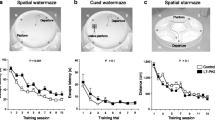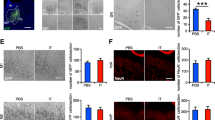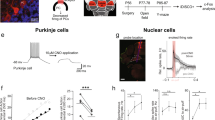Abstract
Lurcher mutant mice (+/Lc) exhibit a massive loss of neurons in the cerebellar cortex and the inferior olivary nucleus, while deep cerebellar nuclei are essentially intact. To discriminate the relative participation of the cerebellar cortex and deep structures in learning and memory, 3 to 6-month-old +/Lc mice were subjected to a spatial learning task derived from the Morris water escape. They were able to learn to escape as well as their strain-matched controls (+/+). Seven days later, their scores showed that they had memorized the spatial environment but not as accurately as +/+ mice. Cerebellectomy before training did not significantly alter the escape learning capabilities of either group, whereas cerebellectomy performed after learning completely abolished retention in +/+, as well as in +/Lc, mice. These results suggest that the cerebellum, although not necessary for learning a spatial task, plays a crucial role in its retention, and that the storing structure of spatial information differs in +/+ and +/Lc mice.
Similar content being viewed by others
REFERENCES
Albus, S. S. (1971). A theory of cerebellar function. Math. Biosci. 10:25–69.
Berthier, M. E., and Moore, J. W. (1986). Cerebellar Purkinje cell activity related to the classically conditioned nictating membrane response. Exp. Brain Res. 63:341–351.
Bianki, V. L. (1962). Conditioned reflexes to light and sound in fishes deprived of the cerebellum. Zh. Vyssh. Nerv. Deiat. 12:962–968.
Buchtel, H. A. (1970). Visual learning deficits following cerebellar damage in rats. J. Comp. Physiol. Psychol. 72:296–305.
Caddy, K. W. T., and Biscoe, T. J. (1979). Structural and quantitative studies on the normal C3H and lurcher mutant mouse. Phil. Trans. R. London 287:167–201.
Caston, J., Vasseur, F., Stelz, T., Chianale, C., Delhaye-Bouchaud, N., and Mariani, J. (1995). Differential roles of the cerebellar cortex and deep cerebellar nuclei in the learning of equilibrium behavior: Studies in intact and cerebellectomized lurcher mutant mice. Dev. Brain Res. 86:311–316.
Dahhaoui, M., Caston, J., Auvray, N., and Reber, A. (1990). Role of the cerebellum in an avoidance conditioning task in the rat. Physiol. Behav. 47:1175–1180.
Dahhaoui, M., Lannou, J., Stelz, T., Caston, J., and Guastavino, J. M. (1992a). Role of the cerebellum in spatial orientation in the rat. Behav. Neural Biol. 58:180–189.
Dahhaoui, M., Stelz, T., and Caston, J. (1992b). Effects of lesion of the inferior olivary complex by 3-acetylpyridine on learning and memory in the rat. J. Comp. Physiol. A 171:657–664.
Desmond, J. E., and Moore, J. W. (1982). A brain stem region essential for classically conditioned but not unconditioned nictating membrane response. Physiol. Behav. 28:1029–1033.
Eccles, J. C. (1977). An instruction-selection theory of learning in the cerebellar cortex. Brain Res. 127:327–352.
Fortier, P. A., Smith, A. M., and Rossignol, S. (1987). Locomotor deficits in the mutant mouse, Lurcher. Exp. Brain Res. 66:271–286.
Gambaryan, J. S. (1960). Conditioned avoidance reflexes induced in dogs with cerebellar lesions. Physiol. Bohemoslov. 9:261–266.
Guillaumin, S., Dahhaoui, M., and Caston, J. (1991). Cerebellum and memory: An experimental study in the rat using a passive avoidance conditioning test. Physiol. Behav. 49:507–511.
Heckroth, J. A. (1994). Quantitative morphological analysis of the cerebellar nuclei in normal and lurcher mutant mice. I. Morphology and cell number. J. Comp. Neurol. 343:173–182.
Ito, M. (1985). Synaptic plasticity in the cerebellar cortex that may underlie the vestibulo-ocular adaptation. In Berthoz, A., and Melvill Jones, G. (eds.), Adaptive Mechanisms in Gaze Control Facts and Theories, Elsevier, New York, pp. 213–221.
Lalonde, R. (1987). Exploration and spatial learning in staggerer mutant mice. J. Neurogenet. 4:285–292.
Lalonde, R. (1994). Cerebellar contributions to instrumental learning. Neurosci. Biobehav. Rev. 18:161–170.
Lalonde, R., and Botez, M. I. (1990). The cerebellum and learning processes in animals. Brain Res. Rev. 15:325–332.
Lalonde, R., Lamarre, Y., and Smith, A. M. (1988). Does the mutant mouse lurcher have deficits in spatially oriented behavior? Brain Res. 455:24–30.
Lalonde, R., Botez, M. I., Joyal, C. C., and Caumartin, M. (1992). Motor abnormalities in lurcher mutant mice. Physiol. Behav. 51:523–525.
Lalonde, R., Filali, M., Bensoula, A. N., Monnier, C., and Guastavino, J. M. (1996). Spatial learning in a Z-maze by cerebellar mutant mice. Physiol. Behav. 59:83–86.
Lavond, D. G., Hembree, T., and Thompson, R. F. (1985). Effect of kainic acid lesions of the cerebellar interpositus nucleus on eyelid conditioning in the rabbit. Brain Res. 326:179–182.
Leaton, R. N., and Supple, W. F., Jr. (1986). Cerebellar vermis: Essential for long term habituation of the acoustic startle response. Science 232:513–515.
Malyukova, I. V. (1963). Influence of the neocerebellum extirpation on situational conditioned reflexes in dog. Zh. Vyssh. Deiat. 13:1052–1058.
Marr, D. A. (1969). A theory of cerebellar cortex. J. Physiol. (Lond.) 202:437–470.
McCormick, D. A., Lavond, D. G., Clark, G. A., Kettner, R. E., Rising, C. A., and Thompson, R. F. (1981). The engram found? Role of the cerebellum in classical conditioning of nictating membrane and eyelid response. Bull. Psychon. Soc. 18:103–105.
McCormick, D. A., and Thompson, R. F. (1984a). Neuronal responses of the rabbit cerebellum during acquisition and performance of a classically conditioned nictating membrane response. J. Neurosci. 4:2811–2822.
McCormick, D. A., and Thompson, R. F. (1984b). Cerebellum: Essential involvement in the classically conditioned eyelid response. Science 223:296–299.
McCormick, D. A., Steinmetz, J. E., and Thompson, R. F. (1985). Lesions of the inferior olivary complex cause extinction of the classically conditioned eyeblink response. Brain Res. 359:120–130.
Morris, R. G. M., Garrud, P., Rawlins, J. N. P., and O'Keefe, J. (1982). Placed navigation impaired in rats with hippocampal lesions. Nature 297:681–683.
Schneiderman Fish, B., Baisden, R. H., and Woodruff, M. L. (1979). Cerebellar nuclear lesions in rats: Subsequent avoidance behavior and ascending anatomical connections. Brain Res. 166:27–38.
Yeo, C. H., Hardiman, M. S., and Glickstein, M. (1984). Discrete lesions of the cerebellar cortex abolish the classically conditioned nictating membrane response in the rabbit. Behav. Brain Res. 13:261–266.
Author information
Authors and Affiliations
Rights and permissions
About this article
Cite this article
Hilber, P., Jouen, F., Delhaye-Bouchaud, N. et al. Differential Roles of Cerebellar Cortex and Deep Cerebellar Nuclei in Learning and Retention of a Spatial Task: Studies in Intact and Cerebellectomized Lurcher Mutant Mice. Behav Genet 28, 299–308 (1998). https://doi.org/10.1023/A:1021675514883
Issue Date:
DOI: https://doi.org/10.1023/A:1021675514883




